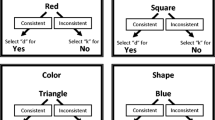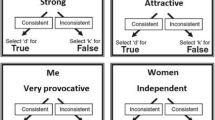Abstract
Two experiments tested a basic assumption of the differential arbitrarily applicable relational responding effects (DAARRE) model by examining the extent to which functional (Cfunc) and relational (Crel) properties of stimuli affect performances on the implicit relational assessment procedure (IRAP). Experiment 1 required participants to complete IRAPs in both their native and a foreign language. Twenty-one Brazilian participants (fluent in both Portuguese and English) completed two IRAPs, one in which Portuguese-language stimuli were predominantly used and a second in which English-language stimuli were predominantly used. The IRAP trial-type containing Portuguese-language (1) labels, (2) positively valenced targets, and (3) response options produced the largest IRAP effect across all eight trial-types (four within each IRAP). Consistent with the DAARRE model, the Cfunc properties of the native language stimuli appeared to dominate over the Crel properties, relative to the foreign language stimuli. Experiment 2 sought to extend Experiment 1 using a known-groups design involving stimuli that were assumed to possess differential Cfunc properties across two groups of Brazilian soccer fans. Two groups of participants were recruited, differing in their support for specific Brazilian soccer teams. They completed a single IRAP task that included the names of the teams and their corresponding team badges. It is critical to note that responding to the IRAP trial-types did not require any explicit evaluative response in that the IRAP required participants to simply categorize team badges with team names as “true” or “false.” The largest IRAP effect observed for each group was for the trial-type that presented the name and badge for that group’s supported team. Both experiments provide support for the DAARRE model analysis by indicating that the Cfunc properties of stimuli are critically important when interpreting IRAP performances. A number of caveats to this conclusion are discussed.



Similar content being viewed by others
Data Availability
The datasets involved in the current study are available from the corresponding authors upon reasonable request.
Notes
“How? It was a completely indifferent sentence, what I said there. Me, you notice it well, I hardly speak French. However, with you I prefer this language to mine, because for me, to speak French is to speak without speaking, in some way: without responsibility, or as we speak in dreams. You understand?”
This participant selection criterion was based on the study by Haydu et al. (2015), which investigated the establishment of equivalent relations by “passionate” soccer supporters.
References
Barnes-Holmes, D., Hayden, E., Barnes-Holmes, Y., & Stewart, I. (2008). The implicit relational assessment procedure (IRAP) as a response-time and event-related-potentials methodology for testing natural verbal relations: A preliminary study. The Psychological Record, 58, 497–516. https://doi.org/10.1007/BF03395634
Barnes-Holmes, D., Barnes-Holmes, Y., Stewart, I., & Boles, S. (2010). A sketch of the implicit relational assessment procedure (IRAP) and the relational elaboration and coherence (REC) model. The Psychological Record, 60, 527–542. https://doi.org/10.1007/BF03395726
Barnes-Holmes, D., & Harte, C. (2022). The IRAP as a measure of implicit cognition: A case of Frankenstein’s monster. Perspectives on Behavior Science, 45, 559–578. https://doi.org/10.1007/s40614-022-00352-z
Barnes-Holmes, D., & Harte, C. (2022). Relational frame theory 20 years on: The Odysseus voyage and beyond. Journal of the Experimental Analysis of Behavior, 17(2), 240–256. https://doi.org/10.1002/jeab.733
Bortoloti, R., de Almeida, R. V., de Almeida, J. H., & de Rose, J. C. (2019). Emotional faces in symbolic relations: A happiness superiority effect involving the equivalence paradigm. Frontiers in Psychology, 10, 1–12. https://doi.org/10.3389/fpsyg.2019.00954
Bortoloti, R., de Almeida, R. V., de Almeida, J. H., & de Rose, J. C. (2020). A commentary on the dynamics of arbitrarily applicable relational responding involving positively valenced stimuli and its implications for the IRAP research. The Psychological Record, 71, 481–486. https://doi.org/10.1007/s40732-020-00413-2
Caldwell-Harris, C. L. (2015). Emotionality differences between a native and foreign language: Implications for everyday life. Current Directions in Psychological Science, 24, 214–219. https://doi.org/10.1177/0963721414566268
Campbell, C., Barnes-Holmes, Y., Barnes-Holmes, D., & Stewart, I. (2011). Exploring screen presentations in the implicit relational assessment procedure (IRAP). International Journal of Psychology & Psychological Therapy, 11(3), 377–388.
Circi, R., Gatti, D., Russo, V., & Vecchi, T. (2021). The foreign language effect on decision-making: A meta-analysis. Psychonomic Bulletin & Review, 28, 1131–1141. https://doi.org/10.3758/s13423-020-01871-z
Fawcett, T. (2006). An introduction to ROC analysis. Pattern Recognition Letters, 27, 861–874. https://doi.org/10.1016/j.patrec.2005.10.010
Finn, M., Barnes-Holmes, D., Hussey, I., & Graddy, J. (2016). Exploring the behavioral dynamics of the implicit relational assessment procedure: The impact of three types of introductory rules. The Psychological Record, 66(2), 309–321. https://doi.org/10.1007/s40732-016-0173-4
Finn, M., Barnes-Holmes, D., & McEnteggart, C. (2018). Exploring the single-trial-type-dominance- effect on the IRAP: Developing a differential arbitrarily applicable relational responding effects (DAARRE) model. The Psychological Record, 68(1), 11–25. https://doi.org/10.1007/s40732-017-0262-z
Finn, M., Barnes-Holmes, D., McEnteggart, C., & Kavanagh, D. (2019). Predicting and influencing the single trial-type dominance effect. The Psychological Record, 69(3), 425–435. https://doi.org/10.1007/s40732-019-00347-4
Haydu, V. B., Camargo, J., & Bayer, H. (2015). Effects of preexperimental history on the formation of stimulus equivalence classes: A study with supporters of Brazilian soccer clubs. Psychology & Neuroscience, 8, 385–396. https://doi.org/10.1037/h0101276
Hayes, S. C., Barnes-Holmes, D., & Roche, B. (2001). Relational frame theory: A post-Skinnerian account of human language and cognition. Plenum.
Kavanagh, D., Matthyssen, N., Barnes-Holmes, Y., Barnes-Holmes, D., McEnteggart, C., & Vastano, R. (2019). Exploring the use of pictures of self and other in the IRAP: Reflecting upon the emergence of differential trial type effects. International Journal of Psychology & Psychological Therapy, 19(3), 323–336.
Maloney, E., & Barnes-Holmes, D. (2016). Exploring the behavioral dynamics of the implicit relational assessment procedure: The role of relational contextual cues and relational coherence indicators. The Psychological Record, 66, 395–403. https://doi.org/10.1007/s40732-016-0180-5
Maloney, E., Foody, M., & Murphy, C. (2020). Do response options in the implicit relational assessment procedure (IRAP) matter: A comparison of contextual relations versus relational coherent indicators. The Psychological Record, 70, 205–214. https://doi.org/10.1007/s40732-019-00360-7
Mann, T. (1927). The magic mountain. Knopf.
Murphy, C., Maloney, E., & Kelly, M. (2022). The role of relational contextual cues and relational coherence indicators on the implicit relational assessment procedure. The Psychological Record, 72, 665–673. https://doi.org/10.1007/s40732-022-00512-2
Pavlenko, A. (2017). Do you wish to waive your rights?: Affect and decision-making in multilingual speakers. Current Opinion in Psychology, 17, 74–78. https://doi.org/10.1016/j.copsyc.2017.06.005
Pidgeon, A., McEnteggart, C., Harte, C., Barnes-Holmes, D., & Barnes-Holmes, Y. (2021). Four selfrelated IRAPs: Analyzing and interpreting effects in light of the DAARRE model. The Psychological Record, 71, 397–409. https://doi.org/10.1007/s4073202000428-9
Pinto, J. A. R., de Almeida, R. V., & Bortoloti, R. (2020). The stimulus’ orienting function may play an important role in IRAP performance: Supportive evidence from an eye-tracking study of brands. The Psychological Record, 70, 257–266. https://doi.org/10.1007/s40732-020-00378-2
Power, P. M., Harte, C., Barnes-Holmes, D., & Barnes-Holmes, Y. (2017). Exploring racial bias in a European country with a recent history of immigration of black Africans. The Psychological Record, 67, 365–375. https://doi.org/10.1007/s40732-017-0223-6
Schmidt, M., de Rose, J. C., & Bortoloti, R. (2021). Relating, orienting and evoking functions in an IRAP study involving emotional pictographs (emojis) used in electronic messages. Journal of Contextual Behavioral Science, 21, 80–87. https://doi.org/10.1016/j.jcbs.2021.06.005
Funding
This research was supported by the National Institute of Science and Technology on Behavior, Cognition, and Teaching (INCT-ECCE). The INCT-ECCE is financially supported by the Fundação de Amparo à Pesquisa do Estado de São Paulo (FAPESP, Grant # 2014/50909-8), the Coordenação de Aperfeiçoamento de Pessoal de Nível Superior (CAPES, Grant #88887.136407/2017-00), and the Conselho Nacional de Desenvolvimento Científico e Tecnológico (CNPq, Grant # 465686/2014-1). Preparation of this manuscript was supported by a productivity research grant to the first author by the CNPq (Grant # 309041/2021-0) and by a fellowship awarded to the third author by FAPESP (Grant #2019/24210-0).
Author information
Authors and Affiliations
Contributions
RB conceived the research, supervised data collection, and contributed to writing the article. MS assisted in conceiving the research, collected and analyzed data. CH discussed the data and contributed to writing the article. DBH also discussed the data and contributed to writing the article.
Corresponding authors
Ethics declarations
Conflicts of Interest
The authors declare no known conflicts of interest.
Ethical Approval
All procedures performed involving human participants were in accordance with the ethical standards of the institutional and national research committee, as well as with the 1964 Helsinki declaration and its later amendments or comparable ethical standards.
Consent to Participate
All participants provided consent prior to participation. The study was conducted in coherence with all necessary ethical standards and was approved by the appropriate ethics review boards. All the authors have approved the manuscript and agree with submission to the journal.
Additional information
Publisher's note
Springer Nature remains neutral with regard to jurisdictional claims in published maps and institutional affiliations.
Rights and permissions
Springer Nature or its licensor (e.g. a society or other partner) holds exclusive rights to this article under a publishing agreement with the author(s) or other rightsholder(s); author self-archiving of the accepted manuscript version of this article is solely governed by the terms of such publishing agreement and applicable law.
About this article
Cite this article
Bortoloti, R., Schmidt, M., Harte, C. et al. Feel the Func: Interpreting IRAP Performances Based on Cfunc versus Crel Stimulus Properties. Psychol Rec 73, 363–373 (2023). https://doi.org/10.1007/s40732-023-00557-x
Accepted:
Published:
Issue Date:
DOI: https://doi.org/10.1007/s40732-023-00557-x




